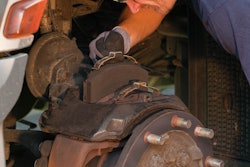The following was published in CCJ's Air Brake Book, 11th edition, sponsored by Silverback HD. CCJ's Air Brake Book is a complementary industry resource, courtesy of our partnership with Silverback HD, the Technology and Maintenance Council and Commercial Vehicle Safety Alliance. You can download the entire Air Brake Book here.
They’re called automatic slack adjusters for a reason, and the manufacturers that make them want to keep it that way.
Yet despite years of warnings, automatic slack adjusters (ASA) continue to be manually adjusted by technicians who may not know any better, or who may be eager to get a truck out of the shop and back out on the road.
Whatever the reason, it's a risky gamble that can result in costly out-of-service violations. During last year's Commercial Vehicle Safety Alliance’s (CVSA) International Roadcheck, brake issues led to 3,992 OOS violations in the U.S. the most by far of any category. Brake problems in the U.S. accounted for 24% of OOS violations during the September 2022 Roadcheck. Tires came in a distant second with 18.5% of total OOS violations.
[Related: Get prepared for 2023 Roadcheck]
With brake problems continuing to dominate OOS violations, experts advise following OEM guidelines on best practices for preventative maintenance which includes putting a halt to manually adjusting automatic slack adjusters. It can not only hinder performance, but also shorten component life.
“If a fleet is manually adjusting a slack adjuster regularly it can harm the longevity of the unit,” warned Chris Christiansen, warranty/technical services coordinator, Accuride Corporation.









